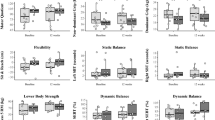Abstract
Individuals with autism spectrum disorder (ASD) are generally less physically active than individuals without disability due to factors such as lack of motor coordination and inadequate transportation resources that can result in various barriers to participation. This affects their independence and may interfere with expectations (e.g., employment) during adulthood. It is essential to explore ways to teach physical activity so people with ASD can generalize skills in community settings. This study examined the effect of a multicomponent behavioral intervention that included (a) the Exercise Buddy application, (b) a system of least prompts, (c) an incremental increase of criteria, and (d) reinforcement to teach three adolescents with ASD functional movement exercises (e.g., squat). All participants increased their mastery of performing these exercises compared to baseline and generalized these skills across two community settings.

Similar content being viewed by others

References
Bellini, S., & Akullian, J. (2007). A meta-analysis of video modeling and video self-modeling interventions for children and adolescents with autism spectrum disorders. Exceptional Children, 73, 264–287. https://doi.org/10.1177/001440290707300301.
Bodde, A., & Seo, D. (2009). A review of social and environmental barriers to physical activity for adults with intellectual disabilities. Disability and Health Journal, 2, 57–66. https://doi.org/10.1016/j.dhjo.2008.11.004.
Criado, K.K., Sharp, W.G., McCracken, C.E., De Vinck-Baroody, O., Dong, L., Aman, M.G., et al. (2017). Overweight and obese status in children with autism spectrum disorder and disruptive behavior. Autism, 22(4), 1–10. https://doi.org/10.1177/1362361316683888.
Fittipaldi-Wert, J., & Mowling, C. M. (2009). Using visual supports for students with autism in physical education. Journal of Physical Education, Recreation and Dance, 80, 39–43. https://doi.org/10.1080/07303084.2009.10598281.
Kennedy, C. H. (2005). Single-case designs for educational research. Boston: Pearson/Allyn and Bacon.
King, A. M., Thomeczek, M., Voreis, G., & Scott, V. (2014). iPad® use in children and young adults with autism spectrum disorder: An observational study. Child Language Teaching and Therapy, 30, 159–173. https://doi.org/10.1177/0265659013510922.
LaLonde, K. B., MacNeill, B. R., Eversole, L. W., Ragotzy, S. P., & Poling, A. (2014). Increasing physical activity in young adults with autism spectrum disorders. Research in Autism Spectrum Disorders, 8, 1679–1684. https://doi.org/10.1016/j.rasd.2014.09.001.
Lang, R., Koegel, L. K., Ashbaugh, K., Regester, A., Ence, W., & Smith, W. (2010). Physical exercise and individuals with autism spectrum disorders: A systematic review. Research in Autism Spectrum Disorders, 4, 565–576. https://doi.org/10.1016/j.rasd.2010.01.006.
McCoy, S. M., Jakicic, J. M., & Gibbs, B. B. (2016). Comparison of obesity, physical activity, and sedentary behaviors between adolescents with autism spectrum disorders and without. Journal of Autism and Developmental Disorders, 46, 2317–2326. https://doi.org/10.1007/s10803-016-2762-0.
Menear, K. S., & Neumeier, W. H. (2015). Promoting physical activity for students with autism spectrum disorder: Barriers, benefits, and strategies for success. Journal of Physical Education, Recreation and Dance, 86, 43–48. https://doi.org/10.1080/07303084.2014.998395.
Pan, C., Tsai, C., Chu, C., & Hsieh, K. (2011). Physical activity and self-determined motivation of adolescents with and without autism spectrum disorders in inclusive physical education. Research in Autism Spectrum Disorders, 5, 733–741. https://doi.org/10.1016/j.rasd.2010.08.007.
Platos, M., & Wojaczek, K. (2017). Broadening the scope of peer-mediated intervention for individuals with autism spectrum disorders. Journal of Autism and Developmental Disorders, 48, 747–750. https://doi.org/10.1007/s10803-017-3429-1.
Roid, G. H. (2003). Stanford–Binet intelligence scales. Itasca: Riverside Publishing.
Rosenberg, N. E., Schwartz, I. S., & Davis, C. A. (2010). Evaluating the utility of commercial videotapes for teaching hand washing to children with autism. Education and Treatment of Children, 33, 443–455. https://doi.org/10.1353/etc.0.0098.
Sarol, H., & Çimen, Z. (2015). The effects of adapted recreational physical activity on the life quality of individuals with autism. Anthropologist, 21, 522–527.
Shogren, K. A., Wehmeyer, M. L., Palmer, S. B., Rifenbark, G. G., & Little, T. D. (2015). Relationships between self-determination and postschool outcomes for youth with disabilities. Journal of Special Education, 48, 256–267. https://doi.org/10.1177/0022466913489733.
Sorensen, C., & Zarrett, N. (2014). Benefits of physical activity for adolescents with autism spectrum disorders: A comprehensive review. Review Journal of Autism and Developmental Disorders, 1, 344–353. https://doi.org/10.1007/s40489-014-0027-4.
Srinivasan, S. M., Pescatello, L. S., & Bhat, A. N. (2014). Current perspectives on physical activity and exercise recommendations for children and adolescents with autism spectrum disorders. Physical Therapy, 94, 1–16. https://doi.org/10.2522/ptj.20130157.
Stodden, D. F., Goodway, J. D., Langendorfer, S. J., Roberton, M., A., Rudisill, M. E., Garcia, C., & Garcia, J. E. (2008). A developmental perspective on the role of motor skill competence in physical activity: An emergent relationship. Quest, 60, 290–306.
Todd, T., & Reid, G. (2006). Increasing physical activity in individuals with autism. Focus on Autism and Other Developmental Disabilities, 21, 167–176.
Todd, T., Reid, G., & Butler-Kisber, L. (2010). Cycling for students with ASD: Self-regulation promotes sustained physical activity. Adapted Physical Activity Quarterly, 27, 226–241.
Walker, B. (2015). Growing up on the spectrum: How high-functioning young adults with autism transition to independence (Unpublished honors thesis). University of Puget Sound, Tacoma.
Wechsler, D. (2014). Wechsler adult intelligence scale (4th ed.). San Antonio: Psychological Corporation.
Funding
This study was funded by Ball State University’s Aspire Start-Up grant.
Author information
Authors and Affiliations
Corresponding author
Ethics declarations
Conflict of Interest
The authors declare they have no conflicts of interest.
Ethical Approval
All procedures performed in studies involving human participants were in accordance with the ethical standards of the institutional and/or national research committee and with the 1964 Helsinki declaration and its later amendments or comparable ethical standards.
Informed Consent
Informed consent was obtained from all individual participants included in the study.
Additional information
Laura Bassette, Department of Special Education, Ball State University; Jessica Kulwicki, Department of Educational Psychology, Ball State University; Shannon Titus Dieringer, Department of Special Education, Ball State University; Kimberly A. Zoder-Martell, Department of Special Education, Ball State University; Ryan Heneisen, Department of Speech Pathology and Audiology, Ball State University
Rights and permissions
About this article
Cite this article
Bassette, L., Kulwicki, J., Dieringer, S.T. et al. The Use of a Multicomponent Behavioral Intervention to Promote Physical Activity in Adolescents with Autism Spectrum Disorders across Inclusive Community Settings. Behav Analysis Practice 11, 358–369 (2018). https://doi.org/10.1007/s40617-018-00285-7
Published:
Issue Date:
DOI: https://doi.org/10.1007/s40617-018-00285-7


